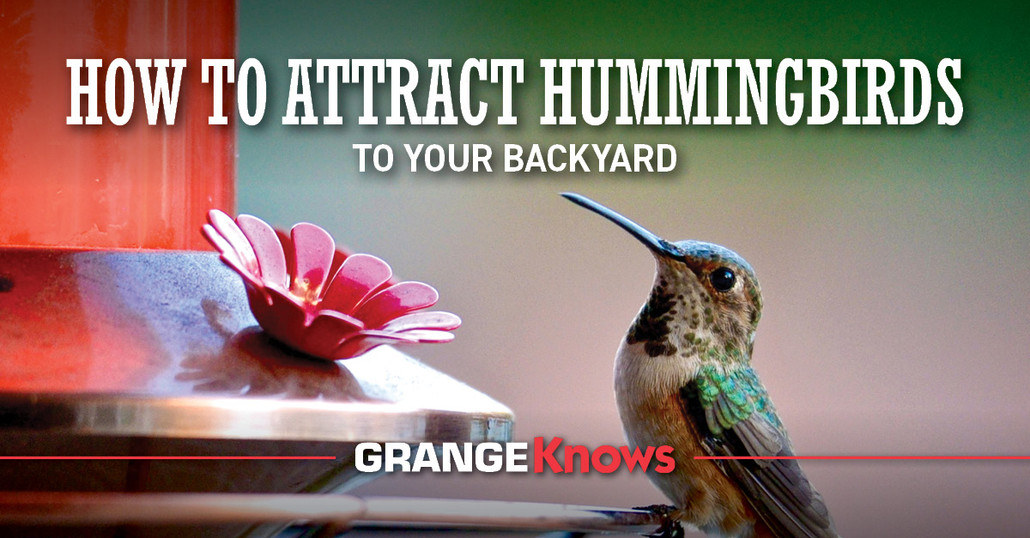
How to Attract Hummingbirds to Your Backyard
Posted by Grange Co-op on 5th Feb 2023
Our porch and patio spaces become more lively when hummingbirds stop by, sipping from the feeder. There are hundreds of species of hummingbirds that live exclusively in the Americas. Only 15 species live in the U.S., which may be why they are not common in your backyard. Knowing when they will migrate through your state can help you see them more frequently. Hummingbirds begin migrating through Oregon between February and early March. In the warmer climate of California, their migration begins in late January and continues through June. If you start now, you might be able to attract more of these fascinating creatures to your backyard.
1. Think Red
Red is a hummingbird’s favorite color. They naturally gravitate toward red flowers and feeders to get the high-octane fuel they need. Plant a variety of red flowers in your yard to help attract more of these little beauties. Some popular red hummingbird flowers include:
- Cardinal flowers
- Peonies
- Hibiscus
- Red daylilies
- Penstemon
- Coral bells
You can also plant late summer and fall flowers like pineapple sage, aster, and goldenrod. While these aren’t all red, they are popular among pollinators.
2. Use the Right Food
People commonly use sugar water for hummingbirds, and that’s good. These little birds need sugar water. You can mix it in a ratio of 4 parts water to 1 part sugar that is boiled for a couple of minutes to dissolve. Don’t add honey, artificial sweeteners, food coloring, or dyes. You can also purchase clear hummingbird food with nectar. Offering food without color means they are attracted to the red flowers or the feeder where they feed on the nectar.
3. Use Multiple Feeders
Most people use one feeder filled with sugar water for hummingbirds and hang it close to their homes. But it takes the right feeders and hummingbird food to get the birds’ attention. Get a good-quality feeder that is easy to take apart and clean.
Hang several feeders with enough space between them so that one bird can’t dominate all the feeders. Combine a variety of decorative styles that add to the beauty of your yard. Hang them in the shade so that the sugar water doesn’t ferment.
Once the weather gets warm, you need to change the water and clean the feeders a couple of times each week. You can clean them with vinegar and water as long as you rinse thoroughly with clear water before refilling them.
Put your feeders up a couple of weeks before the first sightings occur each spring. In the fall, leave them up for a couple of weeks after you sight the last hummingbird visiting them.
4. Provide a Water Source
Hummingbirds like to bathe but require a smaller water flow than other birds. Consider putting in a drip fountain or misting device that these small birds will find attractive.
5. Create a Healthy Ecosystem
Insects are another important aspect of a hummingbird’s diet. They get protein from insects, which helps them grow new feathers and keep their bodies healthy. Here are some ways to create a healthy ecosystem for the birds:
- Eliminate pesticides. Plant insect-pollinated flowers such as roses, sunflowers, orchids, and blue trumpets. Using plants that are native to the area will attract more insects for the birds to feed on.
- Hang baskets of overripe fruit near hummingbird feeders. Those same annoying fruit flies that drive you crazy in your kitchen are a treat for hummingbirds.
- Provide greenery for nesting. These small birds like to nest near their food sources. Plant some small deciduous trees and shrubs that provide cover as well as small branches as perches where they can rest.
Protect Hummingbirds From Predators
Regardless of how tranquil your backyard seems, predators might be the reason you haven’t been successful at attracting hummingbirds. Some potential threats include:
- Feral or domestic cats, including your cat or your neighbor's. Keep your cat out of the backyard and discourage strays or neighborhood cats from entering.
- If you have large lizards or snakes near your yard, they may go after hummingbirds. They can also visit the feeders you have filled with nectar. Even large insects like praying mantises are predators of hummingbirds when given the chance. To keep out predators, place baffles (umbrella-like covers) above and below each feeder and place feeders away from likely hiding spots for predators.
- If you have a fish pond, the fish or frogs might mistake the tiny birds for insects.
- Some large birds and birds of prey will attack and eat other birds. Providing sheltered perches will help protect the birds from exposure.
Keep an eye on your backyard and eliminate any threats when they happen. For example, relocate snakes or lizards. Although it isn’t possible to deter all predators, you can make your yard a lot more attractive to hummingbirds than to the predators that mean them harm.
Grange Co-op Is Here to Help
Whether you are looking for high-quality hummingbird feeders, quality food, or other items for your backyard, Grange Co-op has what you need. If you have questions, contact us for help getting the right products for your needs.
